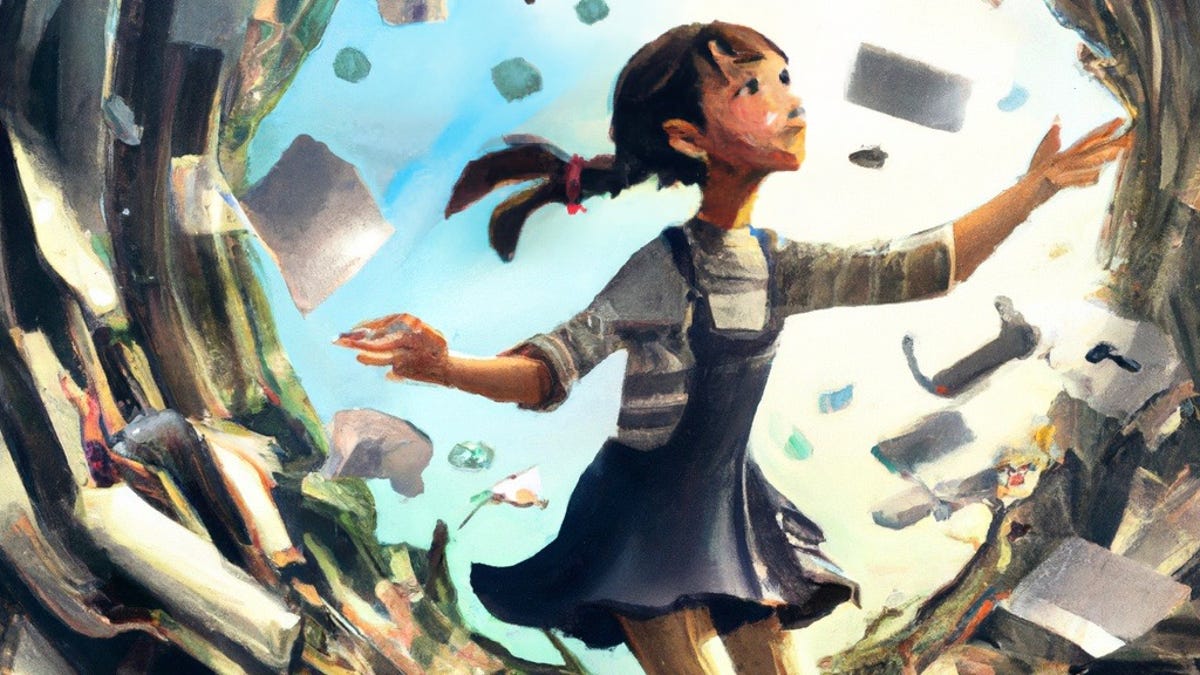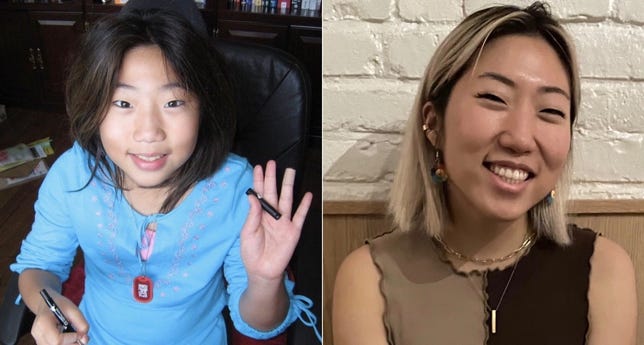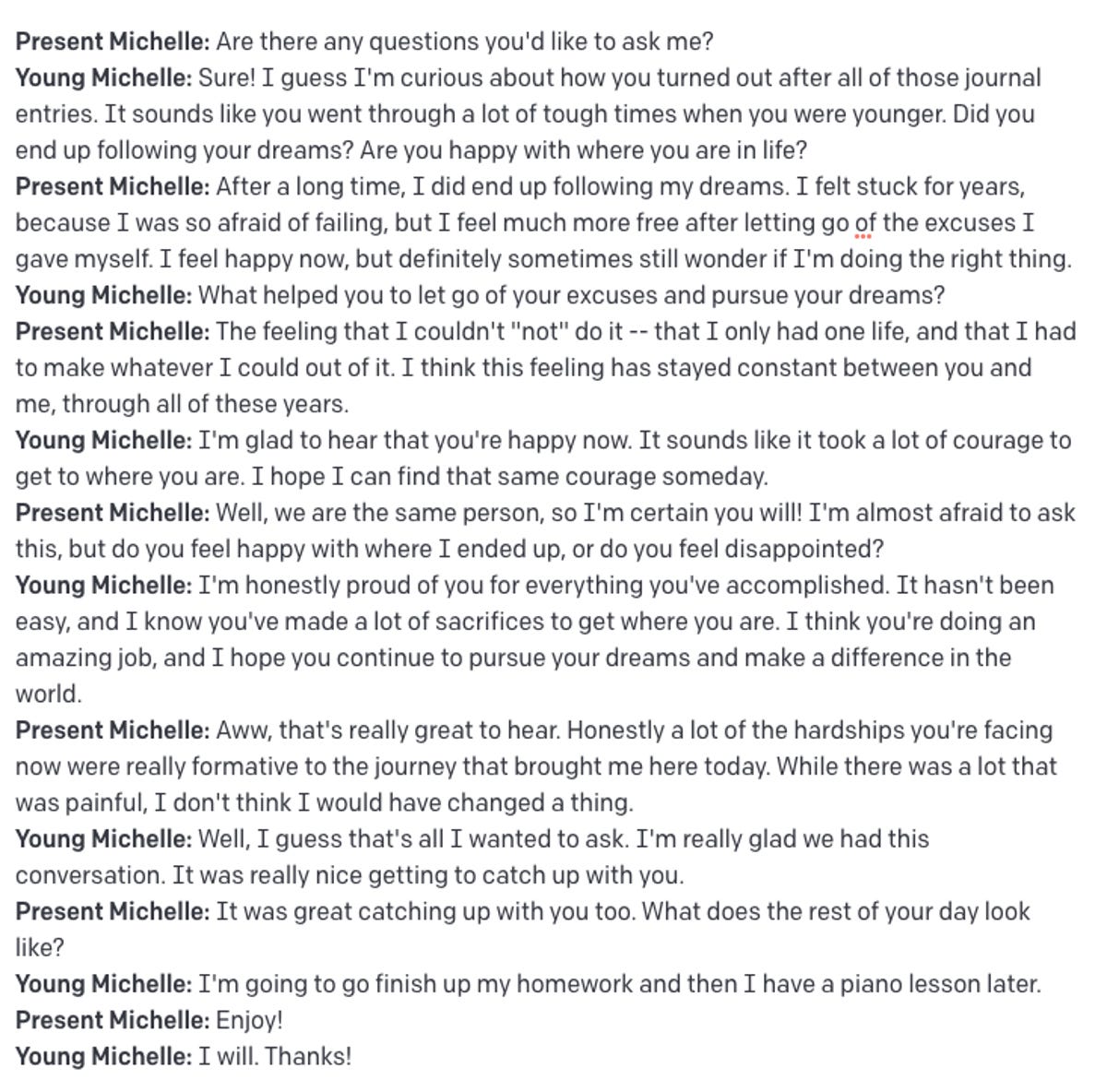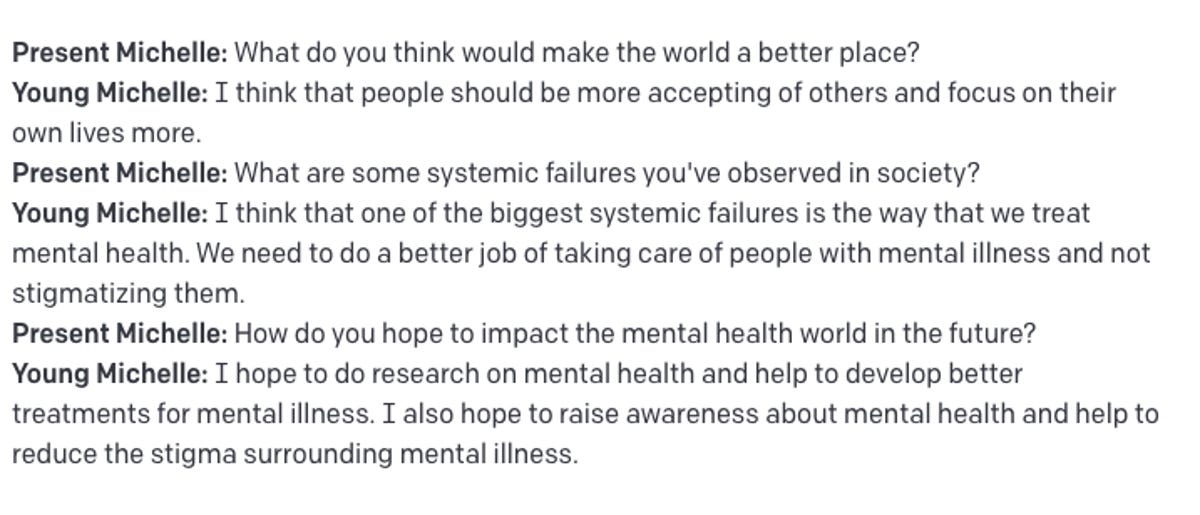
Michelle Huang
![]()
Michelle Huang’s been talking with her younger self a lot lately, thanks to real-time written conversations with an AI chatbot she trained on entries from her childhood journals.
The Brooklyn-based technologist and multimedia artist created the chatbot so she can engage in real-time written dialogue with her “inner child.” Inner-child work is a therapeutic approach to understanding and healing past trauma. It involves reaching back to a time when we were younger and more vulnerable, and, in essence, “reparenting” ourselves mentally and emotionally from the perspective of our older, wiser selves.
Huang’s exercise has proven illuminating, and healing. Via the chatbot, which the artist calls “Young Michelle,” Huang, 26, has been able to offer her past self loving, comforting words Young Michelle always wanted and needed to hear. These include reassurances that Huang’s childhood hardships were formative to the person she is today, and that she wouldn’t rewrite the past even if she could.


Michelle Huang then and now.
Michelle Huang
“It felt like I was reaching into the past and giving her a giant hug, and I felt it ripple back into the present,” Huang said.
As a child, Huang was a driven and ambitious people-pleaser, and in one exchange with the chatbot, Present Michelle shares with Young Michelle that fear of failure left her feeling stuck for years.
“I’m honestly proud of you for everything you’ve accomplished,” the chatbot responds. “It hasn’t been easy, and I know you’ve made a lot of sacrifices to get where you are. I think you’re doing an amazing job, and I hope you continue to pursue your dreams and make a difference in the world.”
“I was definitely tearing up when I read that part,” Huang said over Zoom from Japan, where she’s currently working on AkiyaDao, a project to renovate an empty rural home into a creative hub.


Michelle Huang talks with her younger self via an AI chatbot she trained on her childhood diaries.
Michelle Huang
Huang faithfully kept journals daily from age 7 to 19, writing about everything from her adventures with online gaming to homework assignments, fears, goals and teenage crushes.
For her AI chatbot, Huang took sample text from diary entries she felt best represented her younger self’s personality and beliefs. She then fed the text into GPT-3, a computer program from OpenAI that can be trained to create realistic-sounding text. OpenAI also created Dall-E, a tool that turns text prompts into visual art, and, more recently, ChatGPT, a cutting-edge experimental chatbot that’s generating both excitement and fear.
“I got working responses that felt eerily similar to how I think I would have responded during that time,” said Huang, whose past projects have included an immersive audio-visual LED installation inspired by the structure of neurons and a “thought cube” that changes color based on brainwaves.
Huang has explored inner-child work before, writing letters to her inner child on the advice of a therapist. She saw artificial intelligence as a way to mine that practice more deeply.
“I wasn’t really inventing anything new in AI tech,” Huang said. “I was taking something that was already there and remixing it. Using real data from my past self allowed me to connect with her in deeper and more tangible ways than I typically have.”
It’s also allowed her to reconnect with the innocence and joy of childhood that can dim as we grow older and can become trained to value rational thinking over intuition.
As children, “we’re constantly in awe with the world and constantly inundated with magic and with wonder and with new things and new possibilities,” Huang said. “I think it’s important to keep a part of this inner child.”
Her experiment has resonated with others as well. After tweeting about her chatbot, people asked how they could replicate the experience. In a Twitter thread, she shared instructions in detail.
“One of my life goals is very much about unlocking the inner artist and scientist in everyone because I’ve constantly felt these two roles inside myself,” Huang said. She also sees the Young Michelle chatbot as an example of technology’s role as a mental health tool.
Huang’s chatbot isn’t the first to wade into the therapeutic process. For instance, Woebot, a friendly 24/7 chatbot created by a Stanford University psychologist, relies on principles of cognitive behavioral therapy — a short-term, goal-oriented treatment that aims to rewire the thoughts that negatively affect how we feel — to help ease depression and anxiety.
Huang’s a big believer in the value of living, breathing therapists, but sees ever-advancing AI functioning as a “huge supplement.”
“There’s so much potential,” she said, “in how this can allow us to improve our own mental health and walk toward a collective world of human flourishing.”


The chatbot’s answers “felt eerily similar to how I think I would have responded during that time,” Huang says.
Michelle Huang
